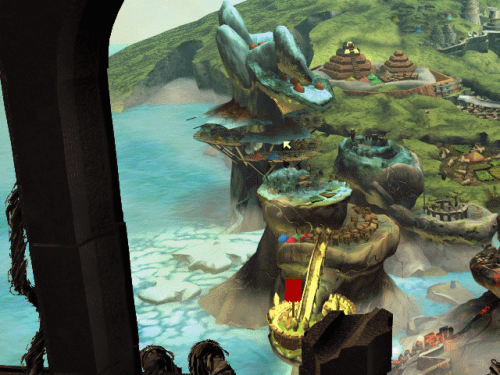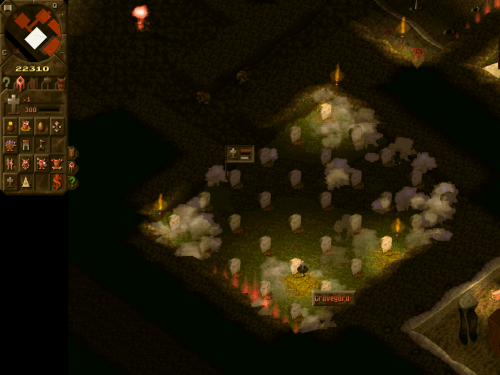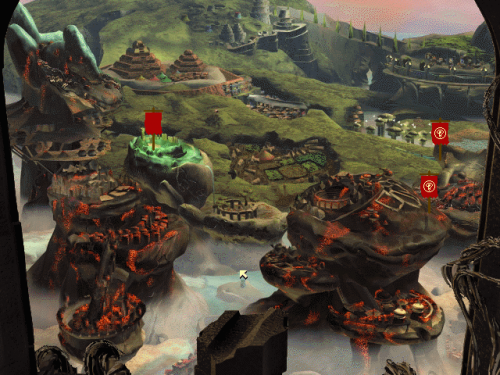I’ll be honest. A minor part of why I started playing Dungeon Keeper is because I’ve been thinking about doing it for a while. A major part, though, is because a mobile sequel was released and there’s a lot of controversy around it. I get what the controversy is about and where it’s coming from, but I’ve been trying to stay positive lately, so instead of saying why I hate a game I probably won’t ever play, I thought I’d play the first Dungeon Keeper and talk about why I love it. First, however, I have a confession to make. I’m a bit of a phony.
Why am I a phony?
Because I’ve never beaten Dungeon Keeper 1 or 2. In fact, I’ve never gotten far in either of the two games at all.
I praise both games every chance I get and they’re definitely some of my favorite games ever, but for the kid me, they were just too difficult to wrap my head around.
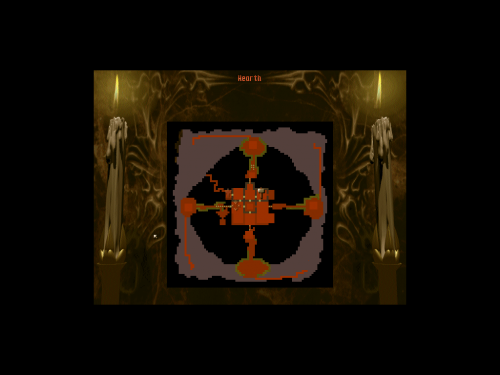
Pictured: This map had bonuses in the corners, above water, so I accidentally made my dungeon an unfortunate shape.
I’m the type of player that loves building in his strategy games and in Dungeon Keeper, there’s just too much conflict for me to handle.
Heck, even for the adult me, at this playthrough I’m writing about, I had a lot of trouble beating some of the levels until I managed to figure out to correct approach to playing the game.
Even then, I still lose often.
Some history
I got my first PC for my confirmation. I’m certainly not religious now, but pretty much everyone in Croatia goes through the sacraments regardless of their religiousness. It’s simply a thing you do and you usually get nice presents for it, so most kids look forward to it for that reason alone.
Anyway, I got a PC.
I knew nothing about PCs, so it wasn’t an especially powerful one, but it worked. It as a Pentium at 200MHz, with 32MB of EDO RAM and a 4MB VGA card.
Back then, I also often visited Germany on school breaks because one of my two sisters was working and living there.
While up there, I found a copy of the first Dungeon Keeper game in a bargain bin, so I bought it. It was my best PC purchase to that date. Also, it was in German, but that’s really not important.
I’ve played Dungeon Keeper over and over from that point, but never really got far. In fact, level 10 was about as far as I ever got, and I don’t think I’ve ever beaten any of the bonus levels. The usual for me with Dungeon Keeper was to play until it got too hard, then forget about it for a while and play something else, only to restart the game a few weeks or months later.
In fact, I think I did that with most of the games I played back then. I was not a completionist.
Another fun fact about me and Dungeon Keeper was that it was the first game that introduced me to the whole your PC is not up to par aspect of PC gaming. The game ran smoothly, but after an hour or two of playing, the RAM would fill up, so I would have to restart my PC in order to keep playing. This was a completely alien concept for me, what with only having experience with some crappy handheld devices, the PlayStation, Sega Mega Drive II and a pirate copy of the NES up to that point.
The Vow
I don’t want to be a phony anymore, so I’ve decided to play through and finish both Dungeon Keeper games. I wont do it all at once, but I will do it with Dungeon Keeper 1 now.
But first, some of my thoughts on the game…
So much style!
That’s the thing that makes Dungeon Keeper so attractive for me. The game simply oozes style and atmosphere.
Just look at one of the screenshots included in this posting. It’s low resolution and blurry, but every part of the graphics is consistent.
The thing you can’t see from an image is also that it all fits together perfectly with animations and sound.
The noises of your creature’s feet, the clanging of your imps digging through the caves, everything you hear and see gives you an impression you’re in a dark, gloomy, damp dungeon full of various horrifying, but also interesting and funny things.
Even the narrator is awesome with his good is bad, bad is good talks.
One thing that someone pointed out for me recently is that there are no actual straight lines in the game. The square blocks and hallways aren’t really square. Everything is actually crooked and jagged in some way. I can’t really draw any useful conclusions from that information, but it’s a funny thing you kind of notice and know, but never really think about until it’s pointed out to you.
But I should probably talk about what I actually did in the game…
Mechanics of Dungeon Keeper
…but let’s talk about the mechanics first, for those unfamiliar with the game.
You’re a dungeon keeper and your goal is to make the land a horrible place to live in for any creature of good.
You have a dungeon heart and your imps.
On each level, you dig out underground rooms to house creatures you can attract from a captured portal which is usually nearby. The type of creature you attract depends on the level you’re playing on and the rooms you’ve built. Your enemies are either the forces of good (heroes, usually led by the Lord of the Land), or enemy keepers which are your competition for dominance.

Pictured: The Lair looks simple at first, but each creature’s “bedding” has a different look, so there’s a lot of detail to it.
With heroes, they arrive through portals of their own and try to break through your dungeon walls in order to attack you. Your imps can reinforce walls to stop them from doing this and if you do this right and in time, you can make your dungeon safe and have all the time in the world to train up before taking the fight to them.
There’s a limited number of heroes that get summoned. Once you beat all of them, the Lord of the Land will come and you have to defeat him to beat the level. He’s extra strong, but manageable.
With enemy keepers, you can do the same when it comes to reinforcing your dungeon, but there are additional dynamics in play. Your and the enemy imps usually start taking territories and rooms from each other, which causes conflicts and skirmishes.
Overall, it can get very frantic.
Also, the other keepers have Dungeon Portals of their own, so you can’t just kill of their creatures. You need to take the fight to them and destroy their Dungeon Heart.
Of course, if the same happens to your heart, you lose.
Finally, in later levels, you and the enemy keeper can have access to a spell that destroys reinforced walls, so you’re sometimes never completely safe. That being said, it’s a rare thing for you to have access to this spell and even rarer for the enemy keeper to actually use it.
Features
To keep it simple, these are the things you play with in Dungeon Keeper:
- Rooms you build to create an infrastructure and attract creatures.
- Spells you research in the Library room and use to help out your dungeon and your creatures or hurt the enemy.
- Traps that trolls, skeletons and bile demons can produce in your Workshop room, which you place to help with your dungeon defenses.
- Creatures you attract with rooms or acquire through other means I’ll list next.
- You can build a Prison to imprison enemy creatures and heroes. If a creature dies in prison, they raise up as a skeleton which joins your dungeon.
- You can build a Torture room. If you put an imprisoned hero or creature in the torture room, one of two things can happen. If they during torture, they rise as ghosts under your control. If they live for long enough, they join your dungeon as they are. You can actually get heroes under your control this way.
- You can build a Graveyard room. Store enough corpses into your graveyard and a vampire will rise up to join you. Fun fact: If your dungeon has hell hounds, they will urinate on corpses, increasing the speed of their decomposition and the rate at which you get vampires. I can’t believe I actually wrote that.
And that’s pretty much it. It’s a simple to understand set of mechanics, but it gets extremely deep and complex once you start playing with it.
The most interesting part are the creatures, of course. They have stats and levels. They can train. They have a happiness level you need to keep up in order to keep them in your dungeon. They have a wage, so need to pay attention to your gold reserves. They even have preferences and things they hate.
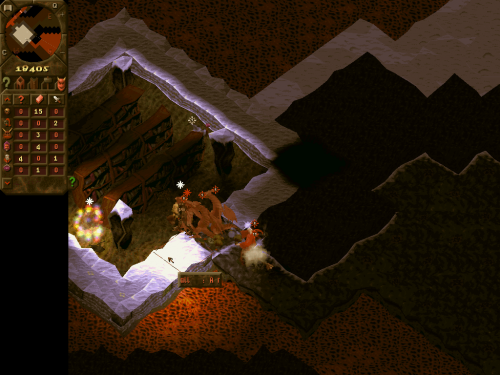
Pictured: Some levels have groups of heroes placed in certain location at start. The usual outcome is that once your imps capture the nearby terrain, you just drop your minions on top of them and hope for the best.
You do not want a warlock and a vampire sitting idly close to each other, for instance, because they will end up fighting.
Dungeon Keeper is not about balanced multiplayer or fair and thoroughly designed gameplay. It gives you a set of rules to mess with and a set of challenges to get through and it somehow makes it extremely fun to do these two things.
It mixes all of that with a healthy dose of dark humor that I enjoy, a lot.
Progressing past Nevergrim
As I said, as a kid, I never got past level 10 – Nevergrim.
This level is special in that your imps don’t actually do much digging. You start with your dungeon heart surrounded by a couple of walls, but as soon as you dig through that, you realize you’re an already dug out, huge cavern surrounded by a wall of gold, which is then surrounded by an enormous lava lake.
To the south, there’s the enemy dungeon keeper, who is your actual enemy on this level.
There are several new things introduced on this level.
First, there’s the no digging part, meaning your rooms are slightly less effective, since they wont have walls.
Then, there’s the fact that there are neutral creatures on the map – dragons. Whichever keeper encounters a neutral creature first, is able to claim it. As soon as one of your creatures gets near it, it will get your colors and go claim a spot in your lair room. This means you need to scout the area as soon as possible.
You are also able to build the final room on this map – the Scavenger Room. In actuality, there’s already a pre-built Scavenger Room on your side of the map, you just have to claim it. This is a good thing because the room is extremely expensive at 750 gold per tile. In comparison, the next room in cost is about 375 gold per tile, I believe.
Having the Scavenger Room attracts hell-hounds to your dungeon, which is another new thing on this level. These creatures are excellent scouts because they seem to have an innate hate for the fog of war. This also means they tend to get lost in fights against enemy creatures, but if you pay attention, they can be very useful.
Also, putting creatures in the Scavenger Room attracts more creatures of the same type from the Dungeon Portal, as well as giving you a chance to claim the enemy keeper’s creatures of that type, which is probably the intended way to beat this level.
Why is it difficult?
Part of the difficulty is that, aside from you having the Scavenger Room, the enemy keeper seems to start off in a better position. They already have a dragon advantage over you and they also seem to start with more gold. Unless you hurry, the keeper will attack and destroy you.
Usually, the AI has problems with rooms, walls and hallways, so they tend to not be as aggressive as they should be.
With this level, since it’s all open, once they get to your side, you pretty much have to win right then and there or it’s all over right away.
So what would usually happen with me is that I’d do all the building up, but I’d over-extend and the enemy would get to my side, trampling over everything I had in an instant.
The trick to beating it was to pay attention.
- I took note of where the closest neutral dragons walk around and I made it my priority to dig out the surrounding gold in those exact places, in order to get them to join as soon as possible.
- I prioritized the library and the training room. The trick to beating this was to win the first big fight and the trick to do that are levels and support spells.
- I realized there’s a group of neutral flies in a small nook on an island in the center of the map. Getting them as soon as possible was key to getting more dragons than the enemy keeper. Losing them in random fights after that wasn’t really important.
- Once I got all that, I kept to myself, and refrained from being aggressive. Overall, the AI isn’t that effective, so if I manage my dungeon properly, I usually get a level advantage soon enough.
Once I did all of these things right, I won the level, but it took me several tries and several hours to finally figure out and do it.
I did eventually make use of the Scavenger Room, but it really wasn’t key to winning the level.
Key was to not waste time and resources and not attract the enemy keeper’s attention before I’m ready. In fact, that’s key in winning pretty much every level in Dungeon Keeper.
Once I got past Nevergrim, the next few levels were relatively easy to beat. I did have a few more losses, but overall, it went smoothly and I’ve cleared the first 15 levels, which is the point I’m writing this first part of the report at.
The final stretch, or so I thought
Dungeon Keeper is a 20 levels long game, with a couple of extra secret levels on top of that.
My goal when I started this was to beat the regular levels and maybe try the secret levels if it doesn’t take too long. That part is not important enough for me to force it under the beating the game tag, however.
I should probably mention that KeeperFX, a mod/fan expansion of Dungeon Keeper that I’m using in conjunction with the GOG copy in order to play it in higher resolutions also includes a metric ton of fan expansions and custom campaigns, including one where you play as the good guys.
Again, I’m not extremely interested in that, though.
Instead, I just wanted to beat the 20 levels the original campaign consist of, and that ended up being challenge enough.
The remaining five levels were surprisingly large in length. It took me a couple of hours to beat each of the penultimate four.
They also ended up being a sort of preparation for the final level, with artificial constraints that made me change my style of play.
One of the levels even left me without a Training Room or a steady source of gold, so I was forced to rely on the Jail and Torture Chamber rooms to defeat and then recruit hero units into my army. With that, I was able to secure a source of gems and then, eventually conquer a hero stronghold in order to get the Training Room.
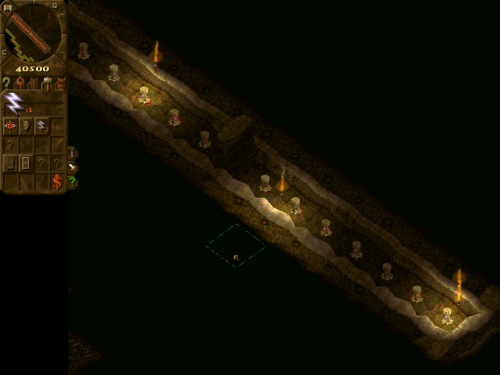
Pictured: Traps seem weak at first, but if properly placed and used, they make all the difference. That didn’t help with the state of the final level, though.
Once I got that, it still took me about an hour or two of trying before I was able to beat the enemy keeper, who has barricaded himself in his own corner of the map.
As for the final level, in my first attempt I seemed to be doing well enough for the first hour or two. The two things I was lacking was the Evil Eye and Destroy Walls spell, as well as the Bridge room.
The lack of Evil Eye was easy enough to deal with – I saved frequently and to different slots.
The lack of the bridge was actually a boon.
There’s a peculiarity with the game. The Guard Post room can serve as a sort of wall when put next to a water tile. Creatures can’t climb from the water onto a Guard Room tile because it’s too high up, so you can effectively block an entire coast line with a bit of gold and a few clicks.
The problem is, all of this made me feel a bit too safe. I was waiting around too often and for too long, so eventually, the enemy keeper destroyed the central heart chamber and captured the Avatar before I even got there.
Once that happened, he took over the entire central area of the map and even reinforced it, effectively blocking me from getting to him at all.
My only option was to use the Call to Arms spell (I do believe that’s what it’s called) to move my units into his territory inch by inch.
The problem with that? He had a bigger total creature count, access to Vampires and overall a stronger army. There was simply no way for me to beat that. Effectively, I locked myself out of beating the level altogether.
The only real option would be to maybe somehow starve him out of gold, since he didn’t have gems and I did, but that just felt like something that would take way to long and suck any fun out of the game.
Confession time!
I cheated. I enabled the cheat mode by adding -alex as a command switch for the .exe, took control of one of my creatures and pressed F12.
Any Dungeon Keeper veteran who’s a bit lower on the moral scale knows this will enable the cheat menu, which gives me options such as enabling all rooms and spells or outright winning the level.
The thing is, I was in such deep poo, I wasn’t even able to win the game with giving myself all the spells. The enemy was simply too powerful. Eventually, I used the auto-win option to at least see how the level ends.
That was no way nearly good enough, though. I made a vow to beat the game, so I was going to. Unfortunately, it would have to wait for a few days, because it took me the better part of a week to get this far, so the weekend was here and I had to postpone it for the week after.
The actual final stretch
So here I am, a week later, more or less.
I started the final level one more time.
This time, I expanded towards the gold as quickly as I could. I also knew the series of rooms past it was devoid of enemies, so I expanded there as well and got all the level increase bonuses.
As this was going on, I built all the rooms I could and as big as I needed them to be.
Then, I used all the level bonuses and suddenly had a bunch of high level creatures.
I punched a hole through my walls and got to the watery area where the group of level 10 tentacles was. As before I was careful not to kill them and instead imprisoned and recruited them into my ranks via torture.
As soon as I could, I started claiming the central island with my imps and soon had all of it. I took down the heart and fought off and killed the horned reaper that attacked me as soon as the heart went down. In retrospect, I could have captured and recruited him as well, but I didn’t think of that in time.
Now, the enemy keeper was in the same position I was during my first attempt on the level. In fact, I was in an even better position, because I could completely block him off with clever use of locked doors and Guard Posts.
But somehow, the enemy keeper still imprisoned the avatar. I’m not really sure what happened there.
Luckily, the level is designed so that you have easy access to the enemy keeper’s prison, without really having to fight your way through his dungeon. I used this fact and dropped a flight of dragons on the avatar, killing him after a long and tedious fight.
Then there was one final trick and the avatar turned out to be a fake, which is something I already knew would happen. A few moments later, my dungeon was assaulted by several groups of heroes, including one with the avatar.
On my first try at this final part of the level, I failed miserably and my heart went down.
On my second try, I was ready. I filled almost every available tile in my dungeon with traps and triggered the attack one more time. This time, all but one of the groups was completely destroyed by the traps. The Avatar’s group had a bunch of dwarves sent in advance as cannon fodder, but that still wasn’t enough to clear the traps, so I managed to significantly soften him up as well before actually having to fight him.
Once he went down for the second time, that was supposed to be it, except KeeperFX added a twist to the final level – I also had to defeat the enemy keeper.
No thank you.
At this point, I was again in a situation where the enemy keeper couldn’t really do anything to me physically, but I couldn’t touch him either. The problem was, he had a higher creature count and it was beginning tho show already – he was able to scavenge my creatures one by one to the point where I wasn’t sure I had enough left to even defeat the avatar.
Basically, there was no chance I’d be able to defeat him.
The original game’s objective was fulfilled, though, so I consider Dungeon Keeper won. It might be a bit of a bland victory, but it still counts in my book.
I’ve completed Dungeon Keeper.
Tips and guides
How to play KeeperFX in windowed mode.
If you run and play KeeperFX using the Launcher.exe, there doesn’t seem to be an option to play in windowed mode. The trick is to open the keeperfx.cfg file within the same folder in a text editor and change all the resolution values from something along the lines of AxBxN to AxBwN. For example, the resolution 640×480x32 would become 640×480w32. If you do this for all of the resolutions set in the file, all parts of the game will run in windowed mode.
How to use cheats in KeeperFX
I actually had a hard time enabling cheats in KeeperFX. There are a couple of methods that the Internet describes, but it’s hard to distinguish between instructors for the original game and those intended for use in the mod. The one that worked for me was as follows:
- Add an -alex command line switch to the executable shortcut, or as an option in the launcher program of KeeperFX (launcher.exe)
- Possess a minion and press F12. The cheat menu should appear. Now unpossess the minion and you will be able to click on the menu entries.
Apparently, there are two more cheat menus that I didn’t get to. The method of enabling them is the same, but one involves pressing Enter on the number pad during minion possession, while the other involves pressing it without possessing anything.
